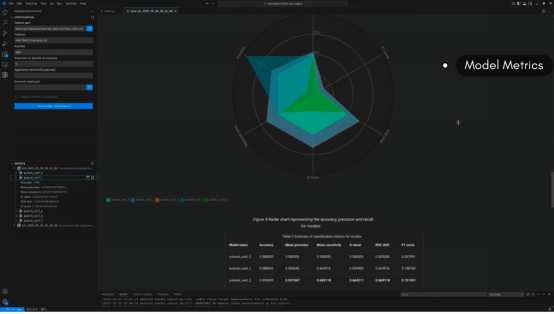Recently, we are delighted to announce that AutoML for Embedded, jointly developed by Analog Devices, Inc. (ADI) and Antmicro, is now officially launched and integrated into the Kenning framework. Kenning is an open-source platform that is not limited by hardware, focusing on optimizing, benchmarking, and deploying AI models on edge devices. AutoML for Embedded aims to enable all users, including embedded engineers and data scientists, to easily utilize efficient and scalable edge AI.
AutoML for Embedded opens up new possibilities, automating the end-to-end machine learning process. It not only enables less experienced developers to build high-quality models, but also helps senior experts significantly improve experimental efficiency. Ultimately, developers will obtain an efficient lightweight model that is not only powerful in performance but also does not exceed the performance limits of the device.

Seamless integration with CodeFusion StudioTM and ADI hardware
AutoML for Embedded is a Visual Studio Code plugin built on the Kenning library, designed to integrate naturally into developers' existing workflows. It is integrated with CodeFusion StudioTM and can support:
· ADI MAX78002 AI Accelerator MCU and MAX32690: Deploy models directly to advanced edge AI hardware.
· Simulation and RTOS workflow: Utilize ReNode-based simulation and Zephyr RTOS to rapidly develop prototypes and conduct tests.
· General open-source tools: Support flexible model optimization and avoid platform lock-in. With detailed step-by-step tutorials, reproducible processes and sample datasets, developers can transform raw data into edge AI applications and complete deployment at an astonishing speed, even without a background in data science.
Designed specifically for developers, with strong support from industry giants
AutoML for Embedded is the fruit of the in-depth cooperation between ADI and Antmicro, integrating profound hardware technology expertise and open-source innovation. We are committed to providing an open, user-centered and scalable toolset to accelerate the popularization of edge AI across various industries.
Michael Gielda, Vice President of Business Development at Antmicro, said: "Relying on Kenning, a flexible open-source AI benchmarking and deployment framework, we have successfully developed automated processes and VS Code plugins, significantly reducing the complexity of building optimized edge AI models." The core of our end-to-end development service lies in creating efficient workflows based on proven open-source solutions to help customers achieve full control over their products. With Renode's flexible simulation capabilities and seamless integration with the highly configurable standardized Zepher RTOS, it is now possible to conduct transparent and efficient edge AI development using AutoML in the Kenning framework.
Working principle: Technical Revelation
AutoML for Embedded adopts advanced algorithms to automatically conduct model search and optimization. It utilizes SMAC (Algorithm Configuration Based on Sequential Models) to efficiently explore model architectures and training parameters, and applies Hyperband and successive halving strategies to focus resources on the models with the greatest potential. Meanwhile, it will check the model size against the device RAM to ensure a smooth deployment.
Candidate models can be optimized, evaluated and benchmarking using Kenning's standard process, and detailed reports on model size, speed and accuracy can be generated, providing an important basis for deployment decisions.
Real application scenarios: Typical use cases
AutoML for Embedded is profoundly changing the development model of edge AI. for example, in a recent demonstration, developers successfully created an anomaly detection model for sensor time series data on the ADI MAX32690 MCU using AutoML for Embedded. This model has been deployed on both physical hardware and the Renode digital twin simulation platform, demonstrating excellent seamless integration and real-time performance monitoring capabilities.
Other potential applications include:
Image classification and object detection on low-power cameras
Predictive maintenance and anomaly detection of industrial Internet of Things sensors
Natural language processing for text analysis on the device side
Real-time motion recognition in sports events and the field of robotics
Start using it immediately
AutoML for Embedded is now available on the Visual Studio Code Marketplace and GitHub
AutoML for Embedded in the Visual Studio Marketplace
AutoML for Embedded on GitHub
Welcome to actively try it out, share your feedback and shape the future of edge AI together with us.
Interested in introducing AutoML for Embedded into your application project? We look forward to collaborating with customers who are actively exploring the potential of edge intelligence. If you are developing AI applications and would like to obtain relevant support for optimizing or deploying models on embedded devices, please feel free to contact us.
Please visit the developer portal to learn more about the support we can provide for your project.
About ADI Corporation
Analog Devices, Inc. (NASDAQ: ADI) is a leading global semiconductor company dedicated to building a bridge between the real world and the digital world to achieve breakthrough innovations in the field of intelligent edge. ADI offers solutions that integrate analog, digital and software technologies to drive the continuous development of digital factories, automobiles and digital healthcare, address the challenges of climate change, and establish reliable connections between people and all things in the world. Analog Devices (ADI) is expected to generate over 9 billion US dollars in revenue for the fiscal year 2024, with approximately 24,000 employees worldwide. ADI helps innovators constantly surpass all possibilities.
All trademarks and registered trademarks are the property of their respective owners.
| 免责声明: 本文章转自其它平台,并不代表本站观点及立场。若有侵权或异议,请联系我们删除。谢谢! Disclaimer: This article is reproduced from other platforms and does not represent the views or positions of this website. If there is any infringement or objection, please contact us to delete it. thank you! |


